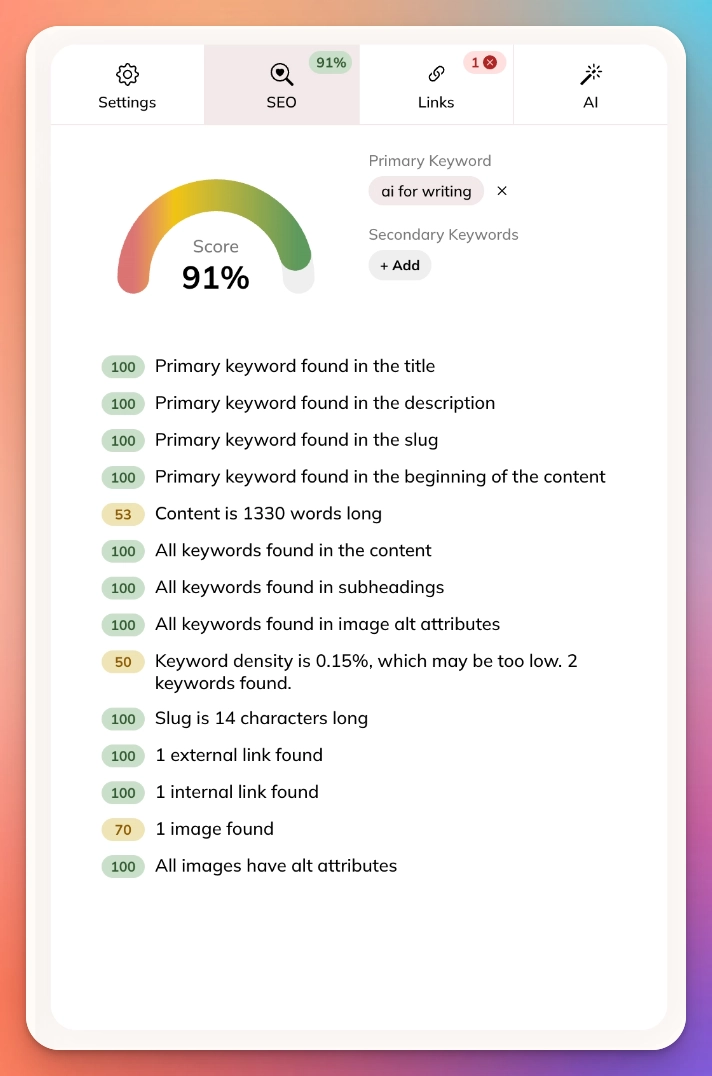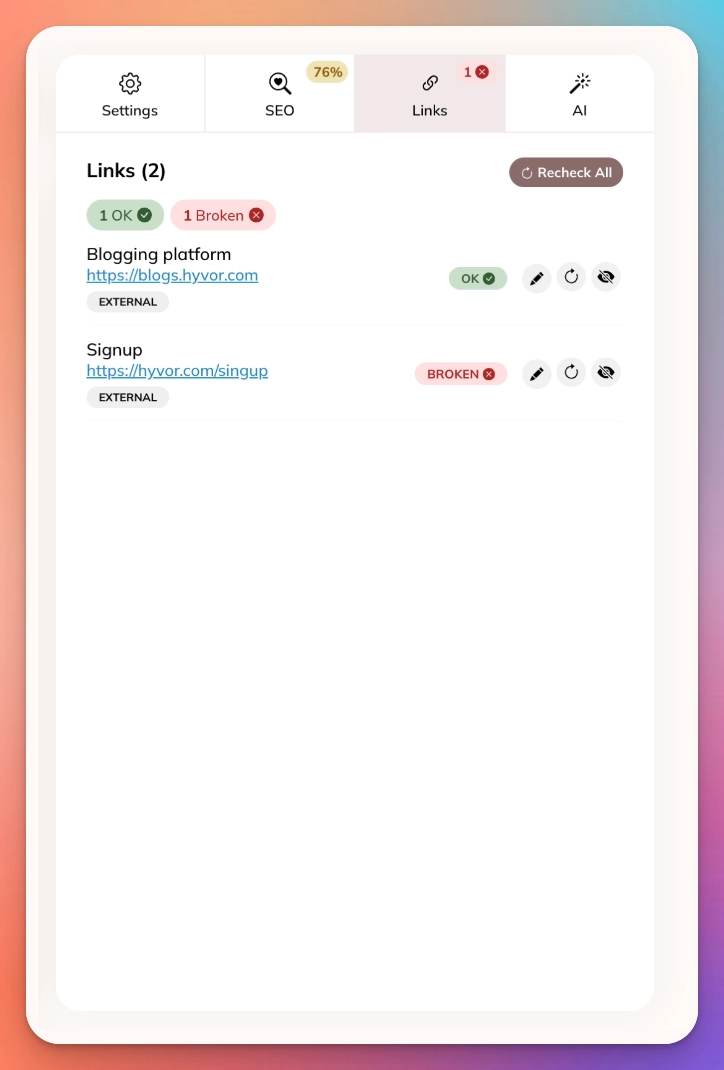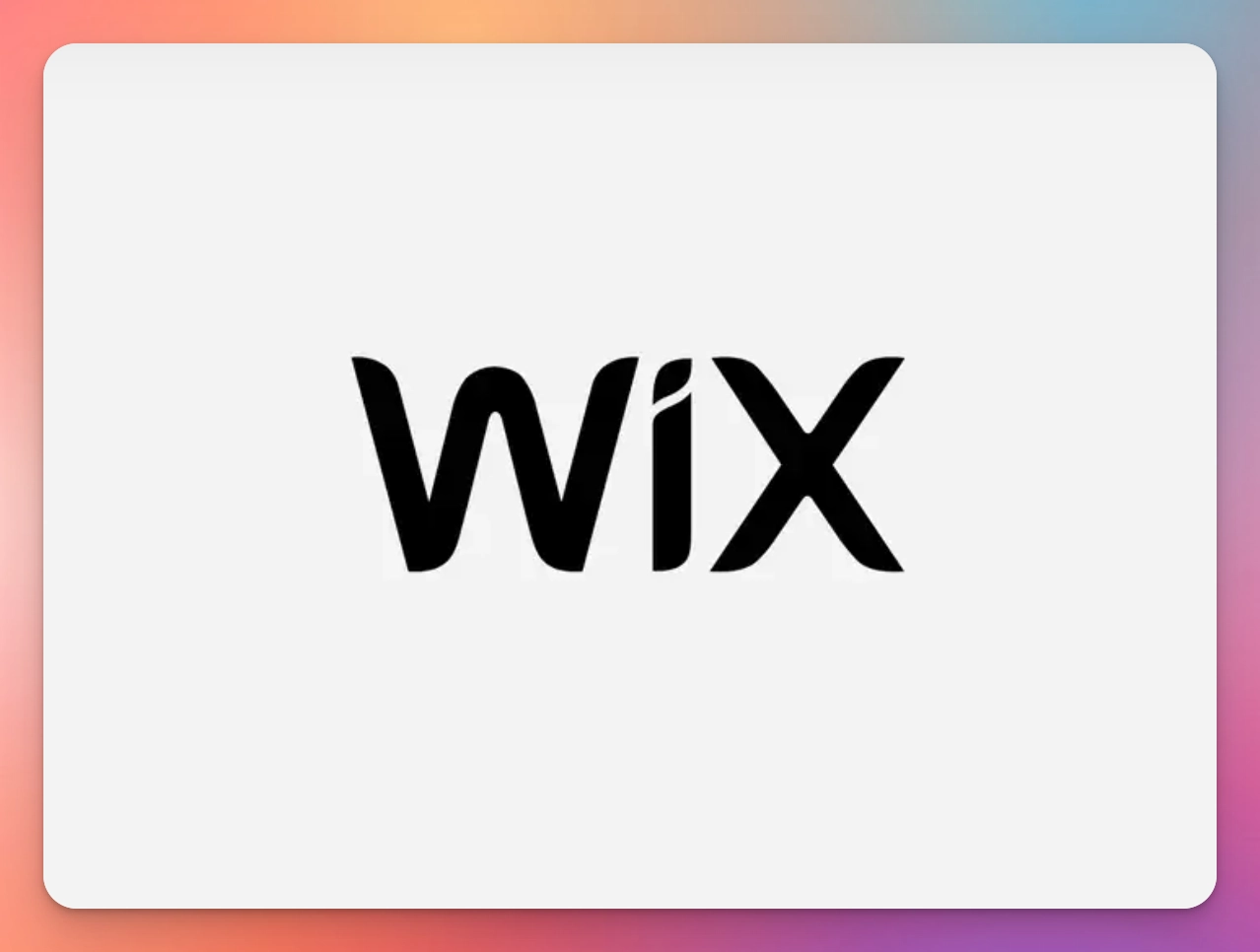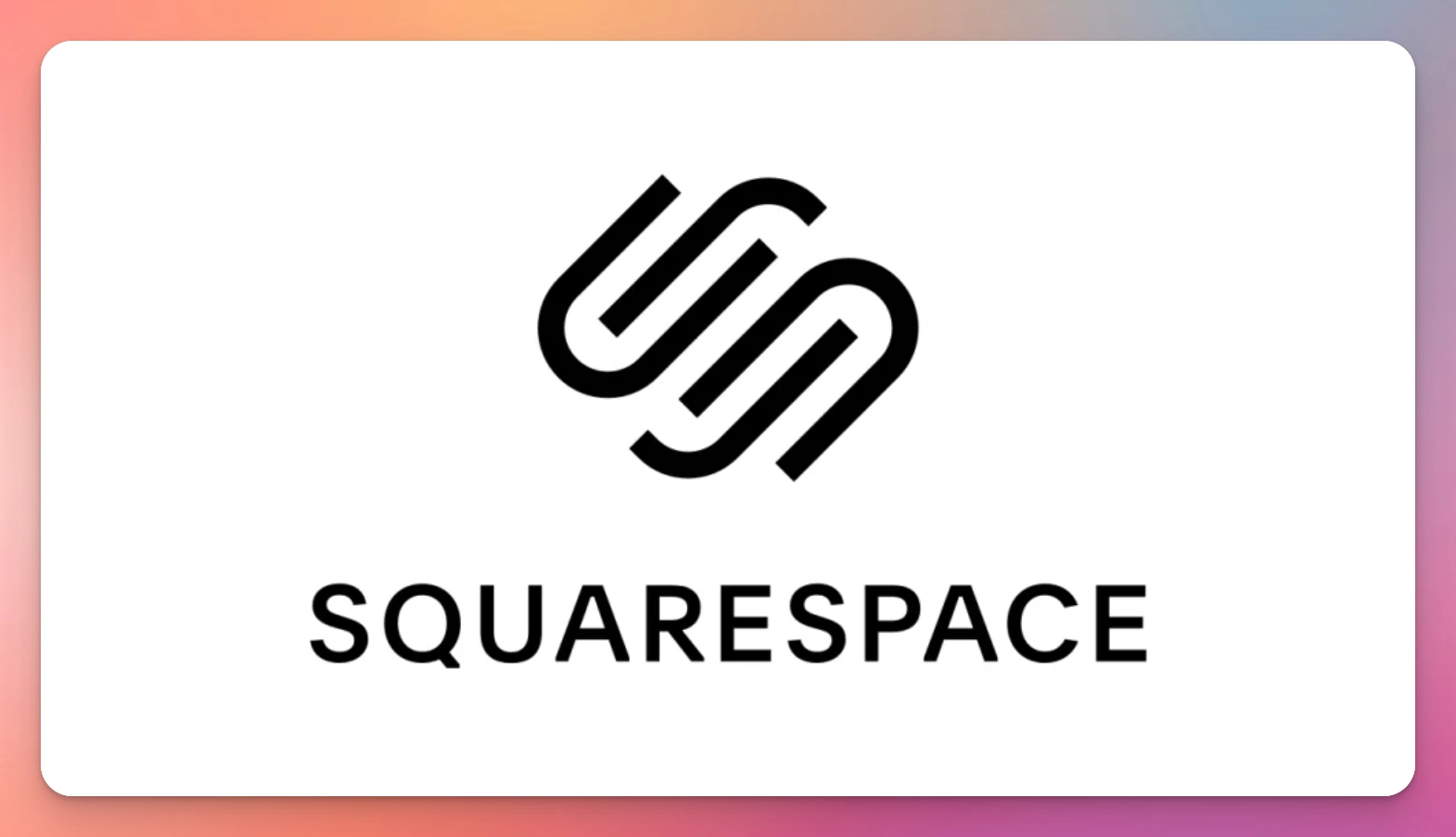Webflow is a Content Management System (CMS) that provides software as a service for website building, blogging, and hosting easily. Its drag-and-drop editor is created to build websites, blogs, and different content for those pages. Furthermore, Webflow is one of the no-code tools beginners can use to start blogging. As we say, when choosing a blogging platform you must consider your goals and requirements for blogging. If the blogging platform you choose does not fulfill your needs and requirements of blogging then you should look for alternatives. The same theory applies to Webflow too. In this case, Webflow alternatives. In this article, we have listed the 5 best Webflow alternatives for you to try.
1. Hyvor Blogs
Features | Hyvor Blogs | Webflow |
Multi-language suported | ✅ (Everything can be translated into different languages easily with AI-powered auto-translation) | ❌ (But they support you if you need) |
Custom Themes | ✅ (You create your own themes or customize existing themes) | ❌ (But they give you templates) |
Blog Ownership | ✅ | ❌ |
User-friendly blog console | ✅ | ❌ (Too complex) |
Custom Domains | ✅ | ✅ |
Ads-free | ✅ | ✅ |
Powerful API | ✅ | ✅ |
Metadata control | ✅ | ✅ |
No vendor lock-in | ✅ | ❌ |
Content exporting | ✅ | ✅ |
Team contribution | ✅ | ✅ |
Free | ❌ (Gives you a 7 days trial) | ✅ |
Social sharing | ✅ | ✅ |
Customer support | ✅ | ✅ |
Powerful posts editor | ✅ | ❌ |
Hyvor Blogs is the first Webflow alternative that we are listing in this Webflow alternatives article. It is a blogging platform that gives you all the facilities to create your own blogging platform easily.
Here are some of the key features of Hyvor Blogs.
Multi-language support by default - You can add new languages to your blog as you prefer. You can start multi-language blogging using different languages and grow your audience. It is just a piece of cake.
Auto translation - No tedious tasks of translating blog posts into different languages. With just one click, you can translate your blog posts easily.
Powerful rich text editor - Hyvor Blogs’s carefully crafted rich text editor makes writing blog posts effortless. Add headings, blockquotes, images, embeds, code blocks, and more.
Customizable Themes - Raydo, Pela, Zing, Torn and more. All of these themes are editable and completely free for anyone using Hyvor Blogs. You can make your own theme for your blog if default themes do not satisfy you.
Custom domains
Right-to-left (RTL) languages supported
Free commenting system - Hyvor Talk is completely FREE in Hyvor Blogs. So, you can have a commenting space on your blog at no cost. A blog without a commenting space is dull.
Real-time SEO analysis - This real-time SEO analyzer gives you suggestions to improve your post's SEO as you write. It checks for keyword usage, internal and external links, and more SEO-related factors.
GPT (AI) for content creation - Chat with GPT to generate content, blog post outlines, and more. GPT is integrated directly into the editor, making it easy to use generated content in your posts.
Broken link analyzer - Hyvor Blogs’s link analyzer checks for broken links in your posts as you write. It also runs a bi-weekly check on all your posts and notifies you via email if any links are broken.
Mobile friendly - You can blog from anywhere using any device. Even using your mobile.
Google fonts, locally
Privacy protected
Complete control - HB does not inject ads, trackers, affiliate links, or paywalls into your blog. It's your blog - You decide everything!
Data Ownership - You own the content you write. You can export your content and move to another platform anytime.
In-built SEO - All you need for technical SEO is in-built in HB
Easy to set up with essential tools
Sub-directory hosting - Host your blog at /blog of your web app: Cloudflare workers, Next.js, Laravel, Symfony.
Headless blogging - If you are planning to start a headless blog make your blog available on different platforms out there -websites, mobile apps, social media platforms, AR/VR, and more- easily, Hyvor Blogs is the best headless Content Management System (CMS) for blogging.
Plus, Hyvor Blogs is completely developer-friendly.
Data API - Access public data of your blog as JSON using our Data API. For example, you can use it to get the latest posts on your blog. The Data API makes Hyvor Blogs work as a headless CMS for an alternative front-end.
Delivery API - Delivery API allows you to host your blog within a subdirectory of your web applications, with the help of Webhooks.
Console API - This is the same API we use in the Console. Automate some of your administrative tasks, or you can even build your own console.
Webhooks - Ping a URL when something happens on your blog (ex: when a post is created).
Not only that but also HB supports web framework integrations such as Symfony, Laravel, etc.
Multi-lingual
Hyvor Blogs is multi-language supported. This means it directly supports you to go with multi-lingual. Explaining simply, in HB your posts can be translated into different languages. And that privilege is not there in Webflow. In Webflow there are two methods for you to go multi-lingual.
Duplicating pages
Using Weglot integration
Duplicating pages means, you may keep the normal version, that is, (domain).com for the English version, and fran.(domain).com, say for the French version of the same blog. That is quite too much maintenance and work. And, it is a time-consuming process and can be tedious. This is why most bloggers do not prefer going multi-lingual though having a multi-language blog is a very good move.
When it comes to multi-language blogging, Hyvor Blogs offers you an AI-powered auto-translating feature to translate your blog posts to any language with just one click. So, no tedious translations anymore.
The other method is using Weglot integration. Weglot works by scanning the content of your original page, detecting the content visible on the page (non-visible too, such as your metadata), and replacing the content with the translations. This is also additional work. But Hyvor Talk supports multi-language blogs. You need only a few clicks to go multi-lingual. So if you want to go with multi-lingual, then Hyvor Blogs would be a great Webflow alternative for you.
Custom themes
Webflow has a bunch of templates that you can install and use on your blog. Plus you can customize those templates. But in Hyvor Blogs, you have got beautiful themes and you can customize them in any way you want.
What is the difference between templates and themes?
A theme controls the design of your entire site. A template defines the layout of a single page
So those templates cannot make a huge difference like themes. A theme represents the uniqueness of your whole blog by every bit of it.
On the other hand, Hyvor Blogs’ themes are streamlined. All themes work the same way following a specific set of guidelines, ensuring the quality of all the themes.
In Hyvor Blogs, official blog themes are free and open-source. The Hyvor Blogs team is working hard on introducing new themes as well. All official themes will forever be free. Therefore, you can easily switch between themes and find out the best one for you.
Here is the latest theme published “Raydo”. You can discover Hyvor Blogs’s themes here.
You can also develop a completely custom theme for your blog. A beautiful and attractive theme makes your blog visitors feel interested in spending time on your blog.
All about blogging
Well, Webflow is all about websites, blogs, and e-commerce. But, Hyvor Blogs is all about blogging. Everything about Hyvor Blogs is blogging. So, Hyvor Blogs has everything you need for blogging while using Webflow requires a sharp eye to choose and use things that are needed for blogging. Webflow is marketed at professionals while Hyvor Blogs focuses on both beginners and Professionals.
Mobile friendly
Additionally, Hyvor Blogs is mobile-friendly. You can blog on the go. No matter where you are, you can maintain or start blogging using any device: using your mobile phone.
In-built SEO Analyzer

Hyvor Blogs has a real-time SEO analyzer in the post editor to help you with on-page SEO. You know how SEO is important when you are running a blog right? Everything depends on SEO. Therefore you have to think about all SEO factors when creating content; that’s quite hard and you might miss things. That is why having such a feature is important. It will help you identify common issues and better optimize your blog posts for search engines.
In-built Link Analyzer

According to a study by Ahrefs, 66.5% of links become broken within 10 years. Broken links can significantly harm your blog’s user experience and SEO. This link analyzer analyzes all the links and lets you know their status. It consists of 2 separate features:
Link analysis: It gives real-time feedback for you as you write your post. This will help you publish your blog post without any broken links. This checks for internal, external, and even anchor links in your post.
Full blog link analysis - This does a bi-weekly (14 days) full-blog analysis checks for all links in your posts and provides you with a report via emails. Learn More.
Chat GPT Integration
Hyvor Blogs has integrated chat GPT 3.5 for you to easily generate content and add it to the editor.
You can generate content and use pre-built commonly used prompts such as SEO keyword ideas, FAQ generators, etc.
Google Fonts, Locally
With this, you do not have to deal with multiple CSS files, @font-face rules, uploading assets, etc. Or, you do not have to use a third-party service like Google Fonts, which comes with a privacy liability. This feature combines the simplicity of Google Fonts and the privacy of locally hosting the fonts. All the fonts (CSS and font files) are served directly from your domain - no requests are sent to Google or any other third party. Learn more.
You own your content
Both blogging platforms have consoles with all the features it has. HB console is user-friendly. You can create and customize your blog very easily with HB. It has a good learning curve. However, the Webflow console is not that user-friendly because it is way too complex. Similarly, it takes time for you to get familiar with the Webflow designer editor.
Custom domains
Furthermore, in Webflow and Hyvor Blogs, you get a domain like abc.webflow.io or abc.hyvorblogs.io. However, if you use this domain, you will realize that you are eventually promoting their brand domain webflow.io putting all your SEO effort. We encourage you to use your own custom domain instead of the subdomains blogging platforms give you. You can add your own custom domain to your Hyvor Blogs blog easily and we do not charge you an extra fee for that.
In HB you can blog with your own custom domain without any interruptions with the plan you take, but with Webflow adding a custom domain is possible but you have to buy specific plans to do so.
Right-to-left (RTL) Language supported
Hyvor Blogs explicitly support RTL languages like Arabic, Farzi, Hebrew, etc. So if you are a blogger looking to blog using an RTL language or looking to run your blog in an RTL language, while it is already running on LTR language, Hyvor Blogs is the best choice for you. HB’s themes are also RTL language supported so you do not have to worry about that.
Free Commenting System
Hyvor Blogs facilitates your blog with their commenting system Hyvor Talk for FREE. How cool is that? Having a commenting space for your blog users is an essential part of having a successful blog as user interaction and engagement is what a blogger expects.
No ads
Furthermore, HB does not show ads to interrupt your blog users. On the contrary in Webflow, you can show ads if you want to. But ads are some kind of interruption for your users.
In-built SEO
Hyvor Blogs has a very powerful API. When you write posts you can change the metadata of those pages. In Hyvor Blogs, you can control the metadata of the blog pages and posts. It is better for the ranking of your blog to have the slug and the focused keywords the same. So the ability to make changes in metadata is beneficial for blog SEO. But built-in SEO needs improvement in Webflow.
Even if you are a multi-language blogger, Hyvor Blogs takes care of multi-language SEO.
Easy to Setup with Essential Tools
As a blogger, you may run ads, set up data collection forms, marketing tools, etc. For example, Google Adsense, Google Analytics, Typeform, Mailchimp, ConvertKit, Memberstack, etc. So, working with those tools is way too easier with Hyvor Blogs.
Here are our guides to essential tool integrations.
Hyvor Blogs is cheap, with no vendor lock-in
Hyvor Blogs does not have a free plan but it offers you a 7-day trial to try Hyvor Blogs. This includes amazing pricing plans with compelling features. But in Webflow there is a free plan but it has a very limited set of features. And not only that but also Hyvor Blogs is free of vendor lock-in which means no vendor lock-in. You can move away from it whenever you want easily. Moreover, you get 24/7 customer support from the HB team to solve any problem you face when using Hyvor Blogs.
For teams
Not only that but also if you are thinking of having a team to maintain your blog or if you already have a team, Hyvor Blogs is a good choice because it gives you team contribution facilities.
On the contrary, the main drawback of Webflow is its complexity. You cannot find most of the essential features straight either in Webflow. But in Hyvor Blogs, you can find everything you want from the Hyvor Blogs console. Unlike Webflow, adapting to HB is just a piece of cake. Hyvor Blogs does not have a drag-and-drop editor like Webflow has. And that makes Hyvor Blogs more simple but powerful and completely functional. So, feel free and comfortable to get started with Hyvor Blogs.
2. Ghost

This is the second among the 5 alternatives to Webflow. Ghost is an open-source blogging platform you bloggers to start blogging. Moreover, that was founded in 2013. It gives you the privilege to start your own blog in a few steps. However, Ghost does not have a free plan just as some other Webflow alternatives do. But they offer you a 14-day free trial to try it.
Ghost is kinda of simple when compared to Webflow because Webflow is too complex in every way; for example – the editor. So things are much easier with Ghost than with Webflow.
And not only that but also Ghost is extremely user-friendly and suitable for newcomers. Ghost, despite its simplicity, has advanced integrations and professional-looking themes. It also comes with SEO and analytics built-in which Webflow needs more improvements in it.
Ghost is perfect for blogging because of its unique features, such as a membership function that allows you to monetize your audience. Its post editor is easier to work with.
If you are familiar with coding, Webflow is not for you because of its limited code editing. But in Ghost, there are no limits. So, if you are hoping for some advanced customizations to your blog, then Ghost is a good choice instead of Webflow. As we said earlier using your own domain is pretty a good move because you own all your efforts in developing your blog from the very beginning. No other organization is taking that. So, you can do it in Ghost also. You can use your own purchased domain in Ghost. There is no extra fee for that.
However, you may need some knowledge in coding to use Ghost: of course when implementing the blog locally on your machine. Not only that but also Ghost has in-built newsletters. You can deliver posts to your audience by email newsletter, so they’ll be the first to know when something new is published. And you can segment your audience and send various newsletters to each segment based on their preferences.
If you don’t feel Ghost is the right choice for you, then look for Ghost alternatives.
3. WordPress

WordPress is a free and open-source platform for building a great blog. According to recent statistics, 455 million websites and blogs are powered by WordPress. Unlike Ghost, it has a massive collection of components that help you to build your blog uniquely. For example themes, plugins, integrations, etc.
It is also a website builder just as same to Webflow apart while acting as a blogging platform at the same time. WordPress does not have a drag-and-drop editor like Webflow has. However, it is much easier to get familiar with WordPress compared to Webflow. Its console is quite advanced but user-friendly. With a few clicks, you can get used to it.
With WordPress, you can add your own purchased domain to your blog without additional charges. And not only that but also it has a powerful editor which is known as Block Editor or Gutenberg Editor. This editor makes it easier for you to edit posts in no time. You can install third-party services and plugins to your blog in WordPress. WordPress has a plugin repository full of third-party plugins including SEO plugins, spam detector plugins, analytics plugins, etc. There are many more kinds of plugins apart from those mentioned above in the WordPress plugin repository. When it comes to hosting in WordPress, every web host service you choose has quick installers for WordPress. So, you can host anywhere easily and find the support you need when you are using WordPress.
As same as Webflow, WordPress has lots of themes for you to try. You can simply activate them on your blog. It does not have in-built SEO controls but they recommend you install the Yoast SEO plugin for free.
For a newbie, WordPress is a great choice; because to play with WordPress and start a blog no coding knowledge is needed. Although it is free, one should spend some money to buy a domain and maintain it. Usually, a domain name costs $14.99 per year. It is a pretty big investment for some newbies, right?
However, if you feel that WordPress does not sound like one of the Webflow alternatives, you can try looking for other Webflow alternatives and WordPress alternatives.
4. Wix

This is the fourth Webflow alternative that we are listing in this article. Wix is a blogging platform that is both free and paid. Technically it is a website-building platform but you can also use it as a blogging platform. Webflow, Wix, and Squarespace all are drag-and-drop blogging platforms. So, if anything in Webflow doesn’t make Webflow the right choice for you, you can try Wix.
Wix is marketed at beginners while Webflow is marketed at professionals while Webflow is marketed at professionals. So if you are a newbie Webflow might be very tricky to get started with. But Wix will be much better as it focuses on newbies.
Wix has an SEO tool (also known as the SEO wizard) that you can use from your dashboard. This alerts you to any SEO improvements that need to be made to your website. You can also handle 301 redirects and change page descriptions, meta titles, and picture descriptions. Wix websites are also mobile-friendly, which adds to the SEO benefits. Finally, you may combine with Google Analytics to get more SEO analytics and discover areas where you can improve.
This alternative has e-commerce facilities for you to start your own store easily. You can choose a featured picture and post header for your Wix blog, add headings, photographs, and embedded videos or audio to your material, and organize articles using categories and tags, among other things.
Not only that, but you can also allow commenting – however, some users claim that it is slow and difficult to administer, especially when compared to more sophisticated blogging engines like Webflow.
Unlike Webflow, you do not need prior knowledge to get started with Wix. Wix offers a free plan so you can try out the features before you commit. However, as you might think, there are a number of drawbacks. For starters, you won’t be able to link a custom domain, and your storage and bandwidth will be limited to 500MB. You also won’t be able to accept online payments or use Google Analytics. Nonetheless, you may use a Wix subdomain to construct and publish your website with all of Wix’s web design features. Wix’s premium plans are divided into two categories: website and eCommerce plans. Accepting online payments necessitates the latter. The former, on the other hand, should be enough for a basic personal or commercial website, portfolio, or blog. Website plans start at $4.50 per month, while eCommerce plans start at $17 per month at the time of writing.
If Wix does not sound like the right choice for you, then you can either look for other Webflow alternatives or you can look for Wix alternatives.
5. Squarespace

Another good Webflow alternative is Squarespace. This is an American website and blog-building platform. Squarespace comes with a solid blogging platform that is ideal for newbies. It only takes a minute of your time to add an example blog with pre-written content for you to edit. It offers blog creation and hosting software as a service, allowing users to create blogs using pre-built blog templates and drag-and-drop features. This is well-known for its appealing design templates, which help businesses and individuals express themselves more creatively. It can assist you from start to finish, whether you are a seasoned webmaster or a complete novice.
The good news for newbies is that Squarespace is a no-code platform; which means you don’t need to know how to code to utilize it. If you are a fan of drag-and-drop editors, Squarespace is the ideal solution because of its drag-and-drop editor. You can change the existing layout or add an article quickly. Without much work, you can switch between different themes easily. SEO analytics and reports can be generated in Squarespace that will help you take prompt actions to improve your blog rankings. However, Squarespace is quite the same as Webflow because of its drag-and-drop editors. The complexity and the learning curves are not that good. That is a common drawback that both platforms have.
Squarespace has better usage coverage in more blog categories. Including Food & Drink, Arts & Entertainment, Science & Education, and Lifestyle, plus 20 other categories. However, the vast majority of professional bloggers favor this platform. Squarespace is a mobile-friendly CMS where you can blog from any device. When it comes to posting editor, Squarespace has custom WYSIWYG if you do not like to edit posts with Markdown editor.
It supports integrations of business systems and applications. Examples, are Zapier, Getty Images, Facebook, Google Analytics, Hyvor Talk, Typekit, Xero, Twitter, and more.
The pricing plan of Squarespace goes as follows.
They allow you to pay annually and monthly under four plans Personal, Business, Basic Commerce, and Advanced Commerce. These plans charge you at the rates of 14$/month, 23$/month, 27$/month, and 49$/month respectively.
At Last…
In blogging, we all come across choosing a good blogging platform. However, our favorite blogging platform may not fulfill our blogging purposes. Then we have to look into the alternatives. In this case alternatives to Webflow. We hope that you got a better idea about alternatives to Webflow and why they become Webflow alternatives for you. If you have comments, questions, and suggestions, please comment down below. Happy Blogging!

Comments